En plein air
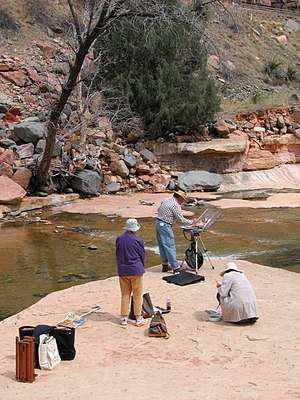
En plein air (French pronunciation: [ɑ̃ plɛn ɛːʁ], French for outdoors, or plein air painting) is the act of painting outdoors. This method contrasts with studio painting or academic rules that might create a predetermined look.
History
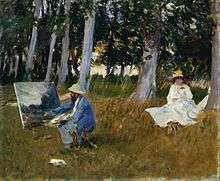
Artists have long painted outdoors, but in the mid-19th century, working in natural light became particularly important to the Barbizon school, Hudson River School, and Impressionists.
In 1830, the Barbizon School in France, inspired by John Constable, enabled artists like Charles-François Daubigny and Théodore Rousseau to more accurately depict the appearance of outdoor settings in various light and weather conditions.[1] In the late 1800s, the en plein air approach was incorporated with the impressionists’ style, and artists such as Claude Monet, Pierre-Auguste Renoir, Frédéric Bazille, and Edgar Degas began creating their work outdoors.[2] From France, the movement expanded to America, starting in California then moving to other American locales notable for their natural light qualities, including the Hudson River Valley in New York.
The Macchiaioli were a group of Italian painters active in Tuscany in the second half of the nineteenth century, who, breaking with the antiquated conventions taught by the Italian academies of art, did much of their painting outdoors in order to capture natural light, shade, and colour. This practice relates the Macchiaioli to the French Impressionists who came to prominence a few years later, although the Macchiaioli pursued somewhat different purposes. Their movement began in Florence in the late 1850s.
The Newlyn School in England is considered another major proponent of the technique in the latter 19th century.[3] The popularity of painting en plein air increased in the 1840s with the introduction of paints in tubes (like those for toothpaste). Previously, painters made their own paints by grinding and mixing dry pigment powders with linseed oil.
The act of outdoor painting from observation has been continually popular well into the 21st century.[4][5]
Equipment and challenges
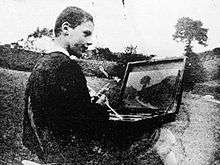
It was during the mid-19th century that the box easel, typically known as the French box easel or field easel, was invented. It is uncertain who developed it, but these highly portable easels with telescopic legs and built-in paint box and palette made it easier to go into the forest and up the hillsides.[6] Still made today, they remain a popular choice (even for home use) since they fold up to the size of a brief case and thus are easy to store.[7]
The Pochade Box is a compact box that allows the artist to keep all their supplies and palette within the box and have the work on the inside of the lid. Some designs allow for a larger canvas which can be held by clamps built into the lid. There are designs which can also hold a few wet painting canvases or panels within the lid.[8] These boxes have a rising popularity as while they are mainly used for plein air painting, can also be used in the studio, home, or classroom. Since pochade boxes are mainly used for painting on location, the canvas or work surface may be small, usually not more than 20 inches (50 cm).[9]
Challenges include the type of paint used to paint outdoors, animals, bugs, onlookers, and environmental conditions such as weather. Acrylic paint may harden and dry quickly in warm, sunny weather and it cannot be reused. On the opposite side of the spectrum is the challenge of painting in moist or damp conditions with precipitation. The advent of plein air painting predated the invention of acrylics. The traditional and well-established method of painting en plein air incorporates the use of oil paint.
Advocates
French impressionist painters such as Claude Monet, Camille Pissarro, and Pierre-Auguste Renoir advocated plein air painting, and much of their work was done outdoors in the diffuse light of a large white umbrella. Claude Monet was an avid en plein air artist who deduced that to seize the closeness and likeness of an outside setting at a specific moment one had to be outside to do so rather than just paint an outside setting in their studio.[10] In the second half of the 19th century and beginning of the 20th century in Russia, painters such as Vasily Polenov, Isaac Levitan, Valentin Serov, Konstantin Korovin and I. E. Grabar were known for painting en plein air.
But enthusiasts of plein air painting were not limited to the Old World. American impressionists too, such as those of the Old Lyme school, were avid painters en plein air. American impressionist painters noted for this style during this era included Guy Rose, Robert William Wood, Mary DeNeale Morgan, John Gamble, and Arthur Hill Gilbert. In Canada, the Group of Seven and Tom Thomson are examples of en plein air advocates.
Notable artists
- Peter Seitz Adams
- Frédéric Bazille
- Stefan Baumann
- Henri Biva
- Ralph Wallace Burton
- Mary Cassatt
- Jack Cassinetto
- William Merritt Chase
- Robert Clunie
- John Constable
- Lovis Corinth
- William Didier-Pouget
- Rackstraw Downes
- Carl Eytel
- Francesco Filippini
- David Gallup
- Antonio López García
- Arthur Hill Gilbert
- Vincent van Gogh
- Winslow Homer
- George Inness
- Theodore Lukits
- The Macchiaioli
- Marvin Mangus
- Frederick McCubbin
- Stanisław Masłowski
- Willard Metcalf
- Claude Monet
- Berthe Morisot
- Edgar Payne
- Robert Antoine Pinchon
- Camille Pissarro
- William Preston Phelps
- Pierre-Auguste Renoir
- Tom Roberts
- Guy Rose
- John Singer Sargent
- Matthew Smith
- Tim Solliday
- Joaquín Sorolla
- Arthur Streeton
- Anthony Thieme
- Tom Thomson
- Henry Scott Tuke
- Andrew Winter
- Robert William Wood
- Mary Agnes Yerkes
Images
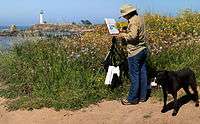 Artist working en plein air, using a Pochade box at Pigeon Point Lighthouse in California.
Artist working en plein air, using a Pochade box at Pigeon Point Lighthouse in California.- En plein air painters painting in Ringwood, New Jersey. Artists are using a French easel on the left of picture, and a Pochade box on the right.
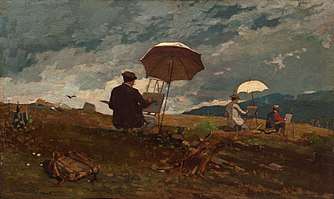 Winslow Homer, Artists Sketching in the White Mountains, 1868, oil on panel, 24.1 × 40.3 cm, Portland Museum of Art
Winslow Homer, Artists Sketching in the White Mountains, 1868, oil on panel, 24.1 × 40.3 cm, Portland Museum of Art.jpg) Camille Pissarro, 1872, Hameau aux environs de Pontoise, oil on canvas, 54 × 74 cm, private collection
Camille Pissarro, 1872, Hameau aux environs de Pontoise, oil on canvas, 54 × 74 cm, private collection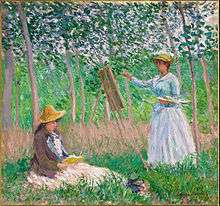 Claude Monet, 1887, In the Woods at Giverny, Blanche Hoschedé Monet at Her Easel with Suzanne Hoschedé Reading, oil on canvas, 91.4 x 97.7 cm, Los Angeles County Museum of Art
Claude Monet, 1887, In the Woods at Giverny, Blanche Hoschedé Monet at Her Easel with Suzanne Hoschedé Reading, oil on canvas, 91.4 x 97.7 cm, Los Angeles County Museum of Art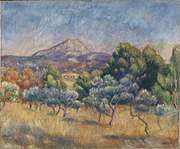 Pierre-Auguste Renoir, c.1888-89 Mount of Sainte-Victoire, oil on canvas, 53 x 64.1 cm, Yale University Art Gallery
Pierre-Auguste Renoir, c.1888-89 Mount of Sainte-Victoire, oil on canvas, 53 x 64.1 cm, Yale University Art Gallery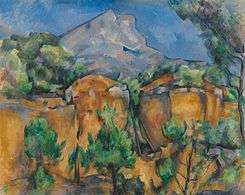 Paul Cézanne, c.1897, La Montagne Sainte-Victoire vue de la carrière Bibémus, oil on canvas, 65.1 × 81.3 cm, Baltimore Museum of Art
Paul Cézanne, c.1897, La Montagne Sainte-Victoire vue de la carrière Bibémus, oil on canvas, 65.1 × 81.3 cm, Baltimore Museum of Art
See also
References
- ↑ Auricchio, Laura (October 2004). "The Transformation of Landscape Painting in France". Heilbrunn Timeline of Art History.
- ↑ Malafronte, Allison (October 2009). "The History of the Plein Air Movement". American Artist: 20–24.
- ↑ "Newlyn School, Landscape Painting Artist Colony, Cornwall: History, Artists, Stanhope Forbes, Frank Bramley". Visual-arts-cork.com. Retrieved 20 August 2010.
- ↑ "Artists who work 'en plein air' share their motivations: Arts". adn.com. 6 June 2010. Archived from the original on 8 August 2010. Retrieved 20 August 2010.
- ↑ "Plein Air Painting - Painting Outside Plein Air". Painting.about.com. 16 August 2010. Retrieved 20 August 2010.
- ↑ "Invention of box/ Field easel". Realism & Impressionism. Retrieved 2015-11-02.
- ↑ "Plein Air". PBS. 6 August 2007. Retrieved 20 August 2010.
- ↑ Pochade Boxes
- ↑ "Pochade box". Artwork Essentials. Retrieved 29 December 2016.
- ↑ Kleiner, F. S., Gardner's Art Through the Ages (15th ed.), Boston, Cengage Learning, 1915
External links
